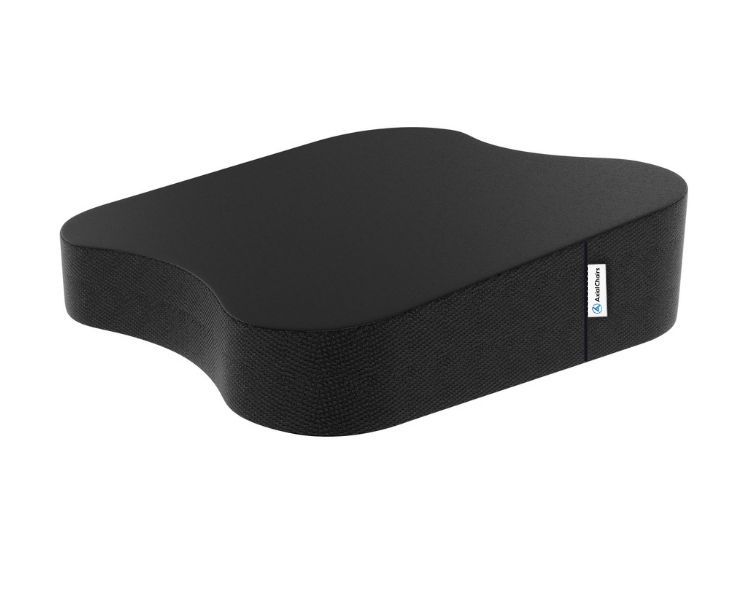Do you ever experience sharp or aching pain in your back when arching backwards? You’re not alone – millions of people deal with this form of back pain on a regular basis. In this blog post, I’m going to take a closer look at what causes this type of discomfort and how it can be managed or treated. Let’s start by discussing the potential reasons why arching your back might cause pain, as well as some lifestyle adjustments you may want to put into place if suffering from consistent problems.
As a general rule, arching your back causes excessive lumbar lordosis and places biomechanical stresses on muscles in the trunk, thighs, and hamstrings, leading to imbalances, weakness, and tightness, contributing to lower back pain. It also impairs neuromuscular control, affecting gait and balance.
Best Seat Cushion for Low Back PainAxial Ergonomic Seat Cushion® | Seat Chair Wedge
Quick Guide: A 30-Second Summary
How do you know if back pain is muscular or spinal?
Back pain can often be the result of a muscular issue or an injury to your spine. Low back pain is a very common complaint and can have many causes including muscle spasms, facet sprains, lumbar strain, disc injuries or joint dysfunction. When you experience low back pain it may be due to damage inflicted on the muscles of your low back caused by bending, lifting or arching your back improperly. If you’re experiencing lower back pain that doesn’t seem to improve with rest and over-the-counter medications, seek medical attention from a doctor or chiropractor for proper diagnosis and treatment options. Pain management may include physical therapy, spinal manipulation, pain injections and/or surgery depending on the cause of the lower back pain.

All Day Comfort & Support
Product Name
Axial Designs™ Seat Cushion
Price
$149
Warranty
1 Year
Type
Posture Wedge
Top Layer
100% Natural Latex (Molded)
Bottom Layer
High-Density Foam
Top Material
Isometric Grippy Vegan Leather
Bottom Material
Non-Slip Material
Side Material
3D Breathable Fabric
Why does it hurt when I curve my back?
When you curve your back, the muscles of your lower backfire and contract to take on the extra load. This can cause strain or tightness in these muscles which may lead to pain. If you are experiencing chronic pain when bending or arching your back, seek medical attention for a proper diagnosis of possible joint dysfunction, disc injury or nerve impingement that could be causing the pain. Treatment options may include physical therapy, chiropractic care, yoga and/or surgery depending on the cause. If medically reviewed treatments do not provide relief from your neck or back pain it is important to search for other alternative remedies such as massage therapy or acupuncture that could provide some degree of relief from the pain.
My Favourite Tip on How to Sit Without Hurting Your Back
To best cater to your seating needs, pay attention to various factors, including chair adjustments. Different methods can be employed, like using an ergonomic cushion and lumbar support. These additions help relieve pressure on your back and legs, enhancing comfort and posture during long sitting sessions. Furthermore, make sure your feet lie flat on the ground and keep a proper distance between your chair and desk. By observing these recommendations, a regular hard chair can be transformed into an ergonomic oasis that supports long-term health and well-being.
Ergonomic Seating Solution
An ergonomic seat wedge (above) can be applied to align your spine and promote balance. This well-designed natural latex solution helps in strengthening core muscles while reducing tension in other areas, such as the shoulders and neck. Moreover, sitting upright is gentler on your hips and knees, as it involves more muscle groups at the same time compared to reclining against a soft surface. This upright posture inhibits stress-inducing habits that individuals may unintentionally develop while working.
What are the symptoms of Spondylolysis?
Spondylolysis is a condition that affects the spine and is characterized by a stress fracture in the vertebral bone. Symptoms of spondylolysis may include lower back pain with activity, tenderness and stiffness along your spine and difficulty bending forward or backwards. If you are experiencing any of these symptoms it is important to seek medical attention to rule out other causes of back pain such as disc herniation or joint dysfunction. Treatment options can include rest, physical therapy, medications for pain management, chiropractic care and/or spine surgery depending on the severity of your condition. It is also important to keep in mind that yoga can be beneficial in reducing low back pain caused by spondylolysis.
I explain the concept of my ergonomic design on a TV show HERE
Why does it hurt to straighten my back?
Back pain can occur when there is excessive tension in the muscles of your lower back. This may happen when you are lifting heavy objects or arching your back too much. When this occurs, the muscles that support your spine become strained and tight causing pain. Pain in the lower back when straightening can also be caused by disc injuries, facet sprains or lumbar strain. If you are experiencing severe or chronic back pain it is important to seek medical attention for proper diagnosis and treatment options which can include physical therapy, medications for pain management, chiropractic care and/or spine surgery depending on the cause of the issue. Additionally, many individuals find relief from their neck and low back pain through yoga or massage therapy.
All Day Comfort & Support
Understanding Low Back Pain When Arching Back
When arching your back, it is important to do so in a slow and controlled manner in order to avoid injury. Arching your back too far can cause strain on the muscles and ligaments of your spine leading to pain. Additionally, disc injuries or facet sprains caused by improper bending could be causing low back pain as well. It is important to seek medical attention if you are experiencing chronic or severe back pain when arching your back in order to properly diagnose any underlying issues that may be causing the problem.
Treatment options for neck or lower back pain can include physical therapy, medications for pain management, chiropractic care and/or spine surgery depending on the cause of the issue. Additionally, many people find relief from their neck or low back pain through yoga or massage therapy.
I’ve written a complete hands-on review about the best sitting position for sciatica, and here is what I tested best with my sciatica patients.
Common Causes of Back Pain while Arching Back
Common causes of back pain when arching your back include muscle strain, disc injury, facet joint sprains and lumbar strain. A muscle strain occurs when the muscles in your lower back are overworked or strained due to excessive bending or arching which can cause tightness and pain. Disc injuries can occur if you bend too far causing a tear in your spinal disc that may lead to pain. Facet joint sprains occur when the small joints between each vertebra become irritated and inflamed. Finally, lumbar strain is caused by an overstretching of the ligaments surrounding your spine leading to stiffness and pain.
The Spine and Its Role in Lower Back Pain
The spine is made up of 33 individual bones (vertebrae) that are stacked on top of one another in order to provide support and structure to your body. These vertebrae are connected by ligaments, muscles and discs which allow for flexibility, stability and cushioning. When the spine is out of alignment due to injury or poor posture, pain can occur. Additionally, when the muscles that support your spine become strained from improper movement, pain can occur as well.
Tips for Managing Pain while Arching Back
There are several things you can do to reduce pain while arching your back. First, make sure to practice good posture by keeping your head up, shoulders back and spine in a neutral position. Additionally, perform gentle stretches and strengthening exercises for the muscles of your lower back before attempting any more intense arching or bending movements. If you are experiencing severe or chronic back pain it is important to seek medical attention in order to determine the cause of the issue and get proper treatment. Lastly, try incorporating yoga into your daily routine as it can help improve flexibility and strength in the muscles around your spine which may help with managing pain associated with arching your back.
Black Friday: 35% Off Today
Typical Delivery 1-3 Days
Strengthening Exercises to Prevent Lower Back Pain
There are several strengthening exercises you can do to prevent and manage lower back pain. These include bridges, squats, hip extensions and deadlifts. Additionally, performing core stabilization exercises such as planks and bird-dogs may help improve the stability of your spine which can also help with managing pain associated with arching your back.
It is important to note that these exercises should not be performed if they cause any additional discomfort or pain. Instead, focus on gentle stretching and relaxation techniques until the pain subsides before attempting any strenuous exercise movements.
Arching your back too far can lead to muscle strain, disc injuries, facet joint sprains and lumbar strain which can all result in neck or low back pain.
Back Pain Warning Signs
While some instances of back pain can be treated with self-care, others necessitate the expertise of medical professionals. Certain warning signs indicate the need for prompt medical intervention, including a fever accompanying the pain, numbness in the groin area, sudden leg weakness, loss of bladder or bowel control, inability to find a comfortable sitting or standing position and increasing pain rather than relief.
Back Pain: Causes
Back pain can be acute or chronic, according to my experience as a chiropractor. Acute back pain lasts from a few days to several weeks before it fades, while chronic back pain persists for at least a year.
Lower back pain is one of the most common types of back pain, which can result from many factors, including:
- congenital skeletal abnormalities such as scoliosis, lordosis, and kyphosis
- degenerative conditions like arthritis, spondylosis, and disc degeneration.
- Other potential causes of low back pain include spinal problems like sciatica, ruptured discs, spinal stenosis, spondylolisthesis, and osteoporosis.
- Additionally, conditions like piriformis syndrome, fibromyalgia, endometriosis, pregnancy, and tumors can also contribute to back pain.
Lifestyle factors can also cause back pain; prolonged sitting, especially with inadequate back support, is more likely to cause back pain, as are overweight people and the elderly; It is also possible to develop back pain as a result of stress, anxiety, or depression, as well as a sedentary lifestyle and poor posture.
In addition to getting enough quality sleep, a healthy back also depends on getting enough quality sleep. I recommend patients maintain regular movement and exercise to reduce back pain. In order to minimize their risk of developing back pain and maintain a healthy back, it is important to maintain a good sitting posture during the day and a proper sleeping position at night.
Summary
Ultimately, arching your back can lead to a variety of problems that may be hard to undo. Muscles in the body become imbalanced and tight, leading to lower back pain. Neuromuscular control may also be negatively impacted, potentially affecting gait and balance. To prevent and reduce these issues, it is important for people to maintain good posture when sitting and standing by keeping their core engaged, feet shoulder-width apart with toes pointed slightly forward. Supplementing regular exercise with stretching and strengthening exercises helps promote stability while avoiding excessive loading on the lumbar spine helping maintain an upright position without unnecessarily stressing the muscles of the low back or hips. Taking time to regularly evaluate one’s posture can benefit long-term physical health as well as the comfort level in everyday activities.






